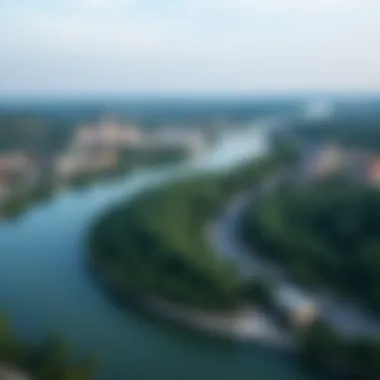Danube 101: Exploring Europe's Vital Waterway


Intro
The Danube River, winding its way through ten countries, offers more than just a scenic route; it serves as a lifeblood for many communities, ecosystems, and economies. Spanning approximately 2,860 kilometers, this majestic river traverses a diverse landscape from the dense forests of the Black Forest in Germany to the serene delta at the Black Sea. The Danube’s journey is not merely geographical; it embodies centuries of history, culture, and environmental dynamics.
Historically, the Danube has been a conduit for trade and cultural exchange. It linked the ancient Roman Empire with its territories and continues to be a vital artery for commerce, connecting bustling urban centers such as Vienna, Budapest, and Bratislava. Beyond its economic relevance, the river also fosters a rich tapestry of cultural exchanges, bringing together different ethnicities and traditions.
However, this great waterway faces significant environmental challenges, from pollution to habitat destruction. The balance between human activity and ecological preservation has never been more critical. This article seeks to explore the journey of the Danube in-depth, examining its profound importance throughout history while addressing contemporary issues and future preservation efforts.
Whether you are an investor, a homebuyer, an enthusiast of natural wonders, or simply someone curious about Europe's second-longest river, this exploration will provide you with valuable insights into the multifaceted role the Danube plays across nations.
Preface to the Danube River
The Danube River, flowing gracefully across ten countries, is not merely a geographical feature; it’s a lifeline that intertwines cultures, economies, and histories. This introduction sets the stage for an extensive exploration that underscores the river's multifaceted importance. How does the Danube stand as a bridge between nations, and why does it captivate historians, ecologists, and travelers alike? Understanding the Danube's essence offers insights into its significant role in shaping both landscapes and societies.
Geographic Overview
The Danube springs from the Black Forest in Germany, meandering through picturesque landscapes and bustling cities before emptying into the Black Sea. It stretches roughly 2,860 kilometers, making it the second-longest river in Europe. Its journey takes it through countries such as Austria, Slovakia, Hungary, and Romania, showcasing a variety of terrains, climates, and ecosystems. Along its path, the river nourishes fertile valleys, creates stunning natural vistas, and serves as a vital waterway for commerce.
Among its key tributaries, the Inn and the Morava contribute to the river's volume, while its confluence with the Sava River near Belgrade marks one of its most significant junctions. The Danube is not just a river; it is an ecosystem teeming with biodiversity, home to over 5,000 species of flora and fauna, many of which are unique to the region. The river's banks host diverse landscapes—from steep cliffs to lush wetlands—emphasizing its geographic importance in European ecology.
Historical Context
The historical significance of the Danube cannot be overstated. It has served as a boundary and a transportation route since ancient times. The Roman Empire relied heavily on the Danube to fortify its borders and facilitate trade. Ruins of ancient castles and forts dotting the riverbanks tell tales of empires rising and falling, and how cultures fused through trade and conflict. Cities like Vienna and Budapest emerged as vibrant centers of culture, nurtured by the waterways that connected diverse communities.
In more recent history, the river has been a pivotal site during both World Wars, and its banks have witnessed revolutions, cultural exchanges, and the birth of new nations. The story of the Danube is intrinsically linked to the broader narrative of Europe itself—a testament to how water shapes not just landscapes but also human endeavors. Through art, literature, and music, the Danube emerges as a protagonist, echoing the thoughts and emotions of those who have encountered its waters.
"The Danube is a thread that weaves together the fabric of Europe, painting a picture of shared heritage and common challenges."
In understanding the Danube River, one taps into the pulse of European history, ecology, and economics, making this exploration vital for those looking to appreciate not just a river, but the stories it carries along its tides.
The Danube's Journey: Source to Delta
The Danube River is a remarkable tapestry of landscapes and cultures that stretches across several countries. Understanding its journey from its origins in Germany all the way to its delta in Romania is crucial for grasping the river's significance. This stretch embodies not only the natural beauty of Europe but also the historical and economic threads interwoven with these waters.
Exploring the Danube's journey helps appreciate its role as a resource, connecting nations, fostering trade, and serving as a vital eco-system rich with biodiversity. This section will illuminate the river's starting point, key countries along its path, and its final destination—the Danube Delta.
Origin and Headwaters in Germany
The Danube begins its life as a modest stream in the Black Forest region of Germany, at the confluence of several rivers. Its headwaters, primarily the Breg and the Brigach, converge near the town of Donaueschingen, often considered the cultural home of the Danube. From this point, it dances through Germany’s varied landscapes, filtering through charming villages and bustling cities.
- Key facts about the origin:
- The river flows for about 2,850 kilometers, making it the second longest in Europe.
- It traverses ten countries—more than any other river on the continent.
Living in proximity to the river, local residents celebrate its natural beauty and history, creating a unique relationship that has lasted centuries. Thus, this origin is not merely a geographic marker; it's a birthplace of rich cultural significance.
Key Countries Along the Danube
As the Danube winds its way through Europe, it embraces a diverse array of cultures, languages, and histories. Here are some notable countries it travels through:
- Austria: The Danube flows through Vienna, one of the world’s most storied cities, famous for its historic architecture and vibrant arts scene.
- Hungary: Budapest, the capital, is split into two parts by the river: Buda and Pest. The Danube is the lifeblood of this city, bringing a lively energy to its cafes and historic sites.
- Serbia: Belgrade sits at the confluence of the Sava and Danube rivers, a place where East meets West, reflecting rich traditions of both.
- Romania: Here, the river takes on a new persona, forming extensive wetlands that are teeming with wildlife and offer a stark contrast to its journey through urban spaces.
Each of these countries contributes to the Danube's character, enriching its waters with unique stories and influences.
The Danube Delta


Finally, the river culminates its journey in the Danube Delta, a UNESCO World Heritage site and one of Europe’s most biodiverse areas. Located in Romania and Ukraine, this delta is a labyrinth of waterways, marshes, and islands, serving as a crucial habitat for a multitude of species.
Nature enthusiasts and bird watchers flock to the delta, which hosts more than 300 species of birds, including pelicans and herons. The vibrant ecology here supports both local communities and tourism, creating a tapestry of life that showcases the natural elegance of this river.
Moreover, the Delta is vital for fishing and agriculture, sustaining the livelihoods of those who call it home.
"The Danube is not just a river; it is an intertwining of cultures, ecosystems, and histories that make it a vital artery of Europe."
As we can see, the journey of the Danube River, from its origins to its sprawling delta, is not just about the water flow; it's a narrative that encapsulates the very essence of European identity, heritage, and economic vitality. Understanding this journey is essential for anyone looking to grasp the river's immense significance.
Cultural Significance of the Danube
The Danube River is not just a body of water; it is a cultural artery that nourishes the soul of Europe, echoing through the realms of literature, art, music and folklore. One might say the river has served as a great muse, inspiring countless artists and thinkers over centuries. Its winding course through diverse countries has allowed it to absorb and reflect the rich tapestry of cultures it encounters. In this section, we will delve into two crucial aspects of the Danube's cultural significance: how it has influenced literature and art, and the folklore and music that intertwine with its flow.
Literature and Art
For centuries, the Danube has appeared in the works of some of the most esteemed writers and artists, serving as a backdrop for stories of love, war, and peace. The river’s beauty and complexity seep into the pages of novels and poetry, inviting readers to ponder the relationship between man and nature.
Authors like Franz Kafka and André Gide have captured its essence in their prose, often using the Danube as a metaphor for life's journey. The river’s meandering path reminds us that life is not always straightforward; it is filled with twists, turns, and the occasional rapid.
Visual artists too held the river on a pedestal. The romantic painter, Caspar David Friedrich, created stunning landscapes portraying the Danube, showcasing its serene beauty set against dramatic skies. His works invite viewers to meditate on the relationship between nature and the human experience, providing a visual context that complements the literary narratives.
The Danube's cultural identity is also linked to notable events. The annual Danube Art Festival in Vienna brings together artists from all over the world to showcase their interpretations of the river's significance. This festival embraces both traditional and modern art forms, fostering a vibrant atmosphere where cultural exchange flows as freely as the water itself.
Folklore and Music
The echoes of the Danube are not silent; they resonate melodically within various art forms. The river plays a vibrant role in regional folklore and musical traditions, often personified as a beloved character or a timeless muse.
One cannot speak of the Danube without mentioning Johann Strauss II, whose waltz, “The Blue Danube,” perfectly encapsulates the river’s grandeur and its romantic imagery. The waltz, a staple of classical music, emerged during a time of great cultural shifts in Europe and is a testament to the river’s influence on the arts. Listening to Strauss is almost like taking a ride down the river, gliding over its surface while being surrounded by the landscapes it nurtures.
Folklore surrounding the Danube is rich with stories of mythical creatures, heroes, and legends. Tales of river spirits who protect the waterway and its surroundings are common, speaking to the deep respect that local populations hold for the river's life-giving gifts. Many narratives highlight themes of harmony, conflict, and resolution, often reflecting the historical struggles faced by the nations along its banks.
Ultimately, the Danube is more than a river; it is an essential thread in the fabric of European culture. From its role in literature and art to its influence on folklore and music, the river stands as a vibrant symbol of creativity, connection, and resilience. In its flow, we discover not just the history of a region but also the shared humanity that it nurtures.
Economic Role of the Danube
The Danube River isn't just a winding body of water; it's a lifeline for several nations, playing an essential role in shaping economies along its banks. The river's significance stretches beyond mere transportation; its influence permeates various sectors, from trade to tourism. Understanding the economic role of the Danube is pivotal for stakeholders who are keen on harnessing this natural resource for the greater good.
Trade and Transportation
The Danube serves as a critical artery for trade within Europe. Stretching over 2,800 kilometers, it connects several countries, creating a pathway that enables goods to flow efficiently across borders. Given that a considerable portion of European freight travels by water, the Danube emerges as a key player in the logistics sector.
A few noteworthy facts about trade along the Danube include:
- Port Infrastructure: Major ports like Vienna, Budapest, and Bratislava facilitate trade, allowing vessels to transport everything from machinery to agricultural products. These ports have invested in modernizing their facilities to handle increasing traffic, thus improving the competitiveness of goods transported via the river.
- Cost-Effective Shipping: Shipping goods by water is often cheaper than by land. This cost-effectiveness is particularly attractive to small and medium-sized enterprises looking to expand their reach without breaking the bank.
- Environmental Impact: Water transportation tends to have a lower carbon footprint compared to road transport. As businesses become more environmentally conscious, using the Danube for shipping presents a viable option that balances profitability with sustainability.
For more on successful trade routes and infrastructure investments along the Danube, check out resources like Wikipedia on Danube Ports.
"The Danube is more than just a river; it is the commercial bloodline that feeds the economies of the surrounding nations."
Tourism Potential
Tourism presents another vital aspect of the Danube's economic contributions. The river has become a popular destination for travelers seeking cultural experiences intertwined with natural beauty. Cities like Vienna and Budapest attract millions of visitors annually, each drawn by the promise of history, culture, and scenic river cruises.
Key elements that demonstrate the tourism potential of the Danube include:
- Cultural Heritage: The Danube passes through countries that boast rich histories, with architecture that ranges from Roman ruins in Serbia to Baroque palaces in Austria. Tourists are often captivated by the tales these towns tell.
- River Cruises: Companies such as Viking River Cruises and AmaWaterways have built their businesses around cruising the Danube. These cruises offer travelers a unique way to experience the various countries, while also providing substantial economic benefits to local communities.
- Natural Attractions: The natural landscapes surrounding the Danube, like the Danube Delta, are UNESCO World Heritage Sites. They offer not only opportunities for ecotourism but also provide a rich habitat for biodiversity, attracting nature lovers and providing local businesses a chance to thrive.


The tourism potential of the Danube is promising, especially as regions work to promote sustainable tourism initiatives. For a deeper dive into the ecological and cultural tourism along the Danube, visit Britannica on Danube Tourism.
In summary, the economic role of the Danube is multifaceted, spanning trade, transportation, and tourism. Its importance is likely to grow as communities recognize the value of this essential waterway, fostering international cooperation and sustainable practices that benefit both the economy and the environment.
Environmental Aspects of the Danube
The Danube River is not merely a meandering body of water; it serves as a lifeblood to various ecosystems and a multitude of communities. Understanding the environmental aspects of the Danube is crucial for appreciating its role in sustaining not just fluvial habitats but also agricultural and urban areas. The river’s health directly impacts biodiversity, local economies, and even global climate patterns. Its protection and sustainable management stand as essential pillars for future generations.
Biodiversity and Ecosystems
The Danube is home to a variety of habitats, which are incredibly rich in biodiversity. The river and its surroundings support more than 5,000 plant species and approximately 105 different fish species, many of which are vital for both ecological stability and human consumption. The Danube’s delta, in particular, is regarded as one of Europe’s most important wetlands, housing unique flora and fauna while acting as a crucial stop for migratory birds.
Moreover, the river's fluctuating waters allow for diverse ecological communities to thrive. For instance, the riverbanks are lined with various types of vegetation, from deciduous forests to marshes, each playing a role in filtering pollutants and stabilizing shorelines.
Key Ecosystems Along the Danube:
- Wetlands: They act as natural sponges, absorbing excess water and filtering pollutants.
- Forests: These provide habitat for numerous species and are essential for carbon cycling.
- Riparian Zones: They help control erosion and maintain water quality through natural filtration.
Keeping these ecosystems healthy is no small feat, given the pressures from agriculture, urbanization, and industries.
Pollution Challenges
Pollution poses one of the most significant threats to the Danube's health and, by extension, its ecosystems. The river stretches across multiple countries, each with varying regulations and enforcement levels regarding pollution. This fragmentation creates challenges in managing waste effectively. Wastewater discharges, agricultural runoff, and industrial effluents contribute to the pollution crisis affecting water quality and biodiversity.
The effects are observable. Fish populations decline due to toxins, while invasive species can gain a foothold in altered ecosystems. Furthermore, human health can be impacted through reliance on contaminated water sources for drinking and irrigation.
Major Sources of Pollution:
- Agricultural Runoff: The use of fertilizers leads to nutrient overloading.
- Industrial Discharges: Factories often release untreated wastewater into the river.
- Urban Waste: Inadequate sewage systems allow for untreated sewage to enter the water.
Such challenges require collective action. International cooperation remains vital, especially through organizations that focus on preserving the Danube and ensuring its waters remain clean and vibrant.
"The preservation of the Danube's ecosystems is not merely a local concern; it reflects a larger imperative that transcends national borders".
The health of the Danube matters not just for the countries along its banks but for the broader environmental landscape of Europe. As we further delve into the economic implications and cooperation needed to tackle pollution, the importance of understanding these environmental aspects becomes even more pronounced.
International Cooperation and Agreements
The Danube River flows through ten countries, making it one of the most significant transboundary waterways in Europe. This geographical reality demands robust international cooperation to manage its resources and address the challenges that arise. In this context, agreements form the backbone of collaborative efforts aimed at preserving the river’s ecological health while simultaneously facilitating shared economic benefits. Effective agreements focus on harmonizing policies, promoting sustainable practices, and ensuring equitable resource allocation.
Danube Commission
Established in 1948, the Danube Commission is a pivotal body that exemplifies international cooperation for the river's management. This commission comprises member states along with the European Union, underscoring a collective commitment to address various challenges and opportunities presented by the river.
The core functions of the Danube Commission include:
- Navigational safety: The commission works to maintain safe and efficient navigation on the river, ensuring that vessels can operate without undue hazard.
- Environmental protection: It also advocates for initiatives that mitigate pollution and promote biodiversity, aligning economic activities with ecological sustainability.
- Infrastructure development: By facilitating joint infrastructure projects, the commission enhances connectivity among nations, promoting trade and tourism while safeguarding the river's natural resources.
This collaboration achieves remarkable feats, but it also presents challenges. Countries may have different priorities influenced by national interests. Nonetheless, ongoing dialogue within the commission helps navigate these waters.
Environmental Conventions
The importance of environmental conventions in the context of the Danube cannot be understated. These agreements not only address pollution but also emphasize the preservation of biodiversity and the protection of ecosystems that the river supports.
Several key environmental conventions focus on the Danube, including:
- The Danube River Protection Convention: This treaty aims to prevent the pollution of the Danube and its tributaries through collaborative measures and sustainable management practices.
- The Framework Convention on the Protection and Sustainable Development of the Carpathians: This agreement acknowledges the interconnectedness of the river and the surrounding mountainous regions, promoting a holistic approach to conservation.
- The European Water Framework Directive: This directive emphasizes the importance of maintaining water quality and habitats, influencing policies within Danube countries and aligning them towards a common goal.


Agreements like these are crucial, as they help ensure that transboundary issues are handled collaboratively, preventing conflicts and promoting sustainable usage of shared resources.
Case Studies Related to the Danube
The Danube River serves as a dynamic backdrop for various case studies that exemplify its multifaceted role in shaping social, economic, and environmental landscapes across Europe. Examining these case studies not only enhances our understanding of the river's significance but also underscores the interconnectedness of the communities it nourishes and the ongoing efforts aimed at preserving its heritage and ecology.
Cities Along the Danube: Vienna, Budapest, and Belgrade
The cities along the Danube—Vienna, Budapest, and Belgrade—stand as vibrant testaments to the river's historical and cultural legacy. Each city offers a unique perspective on how the Danube influences urban development and cultural identity.
- Vienna: This Austrian capital is steeped in imperial history, with the Danube serving as a central axis for trade and transportation since the Roman era. The river not only enhances Vienna’s aesthetic appeal but also plays a crucial role in the city’s economy. Activities like shipping and recreational boating contribute to both tourism and local businesses. Vienna's architecture, influenced by its proximity to the river, showcases extensive waterfronts and parks, inviting residents and tourists alike to connect with the scenery.
- Budapest: The Hungarian capital is divided by the Danube, creating Buda and Pest—the hills and flat areas, respectively. This geographical division reflects the cultural dichotomy of the city. The river has been central to Budapest's identity, enabling it to flourish as a hub of commerce and a site of significant historical events. Some notable landmarks, such as the Chain Bridge and the Parliament Building, are iconic not only for their beauty but also for their historical context, marking them as crucial components of Budapest's urban fabric.
- Belgrade: As the confluence of the Sava and Danube, Belgrade is strategically positioned. The river was historically pivotal for military and trade purposes. Today, it stands as a bustling metropolis that embraces its ethno-cultural diversity. The Belgrade Waterfront, a recent development initiative along the Danube, aims to modernize the city’s infrastructure while enhancing access to the river, marrying the past with future growth.
The interplay between these cities and the Danube highlights how urban planning, culture, and historical events converge in this region. Each city offers a unique yet interconnected narrative, showcasing the broader impact of the Danube across southern and central Europe.
Major Infrastructure Projects
Infrastructure projects along the Danube serve dual purposes: enhancing economic productivity while focusing on sustainability. Significant investments and developments illustrate the balance that must be maintained between progress and environmental stewardship.
- The Danube-Tisa-Danube Canal (DTDC): This ambitious project aims to improve navigation and connectivity among various waterways in Hungary, Serbia, and Romania. It serves as a crucial corridor for trade by linking the Danube with inland rivers. The DTDC is expected to spurr regional economic development, particularly in freight transportation, while presenting challenges related to potential ecological impacts.
- Hydropower Plants: Several hydropower stations exist along the Danube, such as the Iron Gates facility on the Serbia-Romania border. While they provide renewable energy and contribute to energy security, concerns arise regarding their influence on local ecosystems. Debates persist around optimizing the balance between energy production and the ecological integrity of the river basin.
- Flood Management Projects: Flooding remains a recurrent challenge, necessitating the implementation of integrated flood management strategies throughout the Danube Basin. Countries collaborate on levee construction and natural floodplain restoration projects to mitigate risks. These measures not only protect communities but also aim to preserve the ecological functions of the river.
The case studies involving cities and infrastructure projects around the Danube provide key insights into the river's enduring significance. They reveal how historical legacies, urban development, and environmental considerations shape the ongoing narrative of the Danube and its surrounding communities. Through careful analysis and collaborative efforts, there is potential to create sustainable futures in the context of ongoing environmental challenges, all while honoring the river’s rich history and cultural significance.
Future Prospects for the Danube
The future of the Danube River is a topic that holds significant ramifications for various stakeholders, ranging from local communities to global investors. It is not just a matter of managing a river; it's about ensuring a delicate balance between economic progress, environmental sustainability, and cultural heritage. As people and businesses look ahead, understanding the potential shifts in the Danube's status becomes essential.
Sustainable Development Initiatives
In recent years, there has been a strong push for sustainable development initiatives along the Danube. These are not just buzzwords thrown around; they are action plans aiming to protect this vital resource while enabling growth. For instance, local governments and international organizations are working together to promote eco-friendly tourism, which can offer revenue without compromising the river’s health.
Some initiatives include:
- Eco-Tourism Projects: Communities are capitalizing on the Danube's natural beauty, offering tours that highlight its biodiversity. This brings in tourists while raising awareness about the river’s ecological significance.
- Restoration of Wetlands: Efforts are underway to restore and preserve natural wetlands along the riverbanks. These ecosystems are crucial for maintaining water quality and supporting wildlife.
- Renewable Energy Ventures: Many stakeholders are exploring how to harness the river's power for renewable energy, aiming to reduce reliance on fossil fuels. This includes small hydropower plants that will not disturb the river’s natural flow.
These initiatives, albeit challenging, can serve as models for how to maintain economic viability in harmony with nature. They allow businesses and local communities to thrive without jeopardizing the river's future, making them invaluable for long-term growth.
Long-term Environmental Strategies
When it comes to the long-term health of the Danube, strategies must evolve from reactive to proactive. Governments and organizations are increasingly recognizing the need for an integrated approach to environmental management. Planning ahead means considering diverse factors such as climate change, pollution controls, and community involvement.
For a sustainable future, careful planning is essential. Here are some strategies being discussed:
- Pollution Management Frameworks: Stricter regulations on agricultural runoff and wastewater discharge are imperative. These frameworks can help combat harmful pollutants that threaten aquatic life and water quality.
- Climate Change Adaptation Plans: There's a growing acknowledgment that climate change poses significant risks. Adapting infrastructure to mitigate flooding or addressing changing water levels is crucial for preserving both economic activities and natural habitats.
- Cross-Border Partnerships: Since the Danube flows through multiple countries, international collaborations are vital. Agreements on water management help ensure that actions taken in one country don't negatively impact another.
Even small changes in policies can lead to significant impacts—both positive and negative.
In essence, the long-term prospects for the Danube hinge on collaborative efforts that prioritize both human and environmental needs. The recent emphasis on sustainable development signals a commitment not just to economic growth, but to a cohesive strategy that respects and preserves the river's unique ecosystem for future generations.
Culmination
Reflecting on the Danube's significance might seem like a simple task, but the reality is layered with complexities. This river is more than just a body of water — it is the lifeblood of Europe, shaping economies, cultures, and societies. With its roots in the Black Forest of Germany, the Danube meanders through diverse landscapes, all while carrying with it tales of history, trade, and cultural exchange.
Reflecting on the Danube's Importance
The importance of the Danube cannot be overstated. Here are some key points that highlight its value:
- Historical Legacy: The river has been a crucial route for trade and exchange of ideas for centuries. From the Roman Empire to modern-day Europe, it has facilitated movement and connection.
- Economic Impact: It serves as a major trade corridor. Cities along its banks, such as Budapest and Vienna, thrive economically due to waterway transport, bringing in goods and visitors alike.
- Cultural Richness: The Danube has inspired countless works of art, literature, and music, being the muse for everyone from composers like Johann Strauss to poets. It embodies not just a geographical feature, but a shared cultural heritage.
- Environmental Significance: Home to diverse ecosystems, the river’s health is intrinsically tied to the surrounding environments. Ensuring its ecological balance is not only crucial for wildlife but for sustaining local communities that depend on it.
"The Danube is more than just water; it’s a symbol of unity and diversity in Europe, connecting nations and cultures."
It’s vital that we consider its future. Ongoing efforts to preserve its biodiversity while enhancing economic ties requires a delicate balance. With international cooperation, like that from the Danube Commission, fragmented approaches can align to foster sustainable development initiatives.
The Danube represents a multifaceted narrative of Europe, weaving through time and space. Its the living testament to how geography, history, and culture intertwine, shaping not only regions but lives along the way. As both a resource and a treasure, the Danube demands our respect and protection, ensuring that its stories continue for generations to come.







